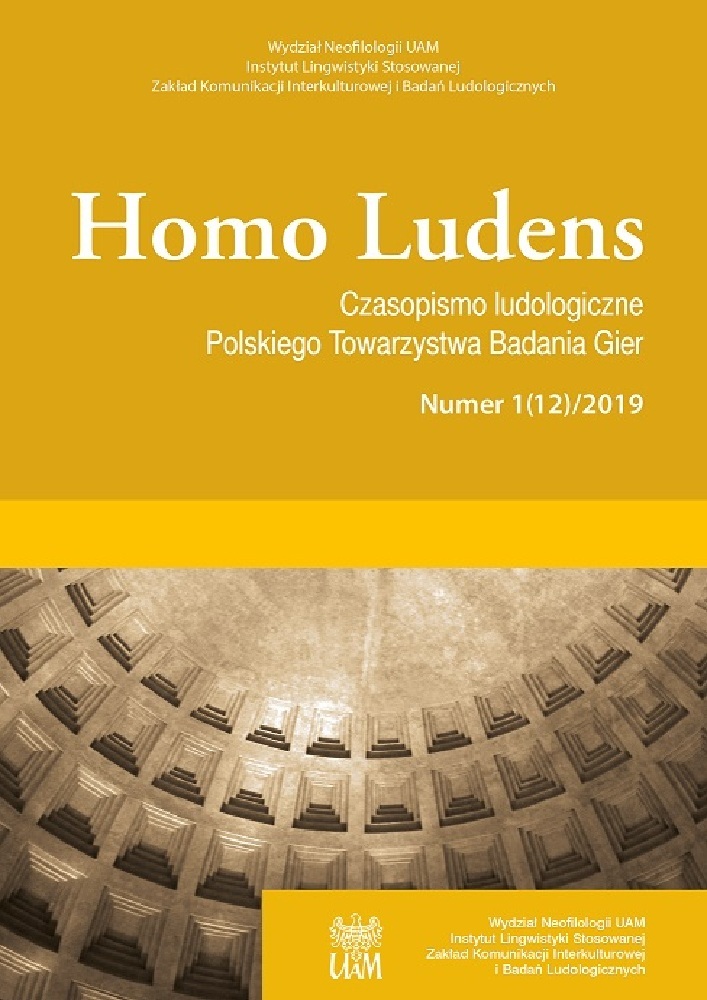Abstrakt
Celem artykułu jest wskazanie różnych typów niepewności w grze, a także ich umiejscowienie w kontekście badań neurofizjologicznych oraz wybranych teorii motywacyjnych. Analizowane są elementy: 1) czystej losowości (hazard i ślepy traf), generowanej przez system; 2) zaprogramowanej złożoności reakcji sztucznej inteligencji; oraz 3) te, które na poziomie taktycznym lub strategicznym związane są z czynnikiem ludzkim. Szczegółowo omówione jest zastosowanie reguł umożliwiających grę wykorzystującą siłę psychiki. Konkluzja prezentuje zyski i straty płynące z potencjalnego wzbogacenia gier o czynniki wytwarzające poczucie niepewności
Bibliografia
Apter, M. J. (1997). Reversal theory: What is it? The Psychologist, 10(5), 212–219.
Arias-Carrión, O., Pŏppel, E. (2007). Dopamine, learning, and rewardseeking behavior. Acta Neurobiologiae Experimentalis, 67(1), 481–488.
Berridge, K. C., Robinson, T. E. (1998). What is the role of dopamine in reward: Hedonic impact, reward learning, or incentive salience? Brain Research Reviews, 28(3), 309–369.
Caillois, R. (2001). Man, Play and Games. Urbana–Chicago: University of Illinois Press.
Calleja, G. (2010). Digital Games and Escapism. Games and Culture, 5(4), 335–353.
Costikyan, G. (2013). Uncertainty in Games. Cambridge, Massachusetts: The MIT Press.
Crawford, Ch. (1982). Design Techniques and Ideas for Computer Games. Byte Magazine, 7(12), 96–108. Online: <http://archive.org/stream/byte-magazine-1982-12/1982_12_BYTE_07-12_Game_Plan_1982#page/n97/mode/2up>. Data dostępu: 31 lipca 2018.
Csikszentmihalyi, M. (2005). Przepływ. Psychologia optymalnego doświadczenia (tłum. M. Wajda-Kacmajor). Taszów: Biblioteka Moderatora.
Czajkowski, M. (2015). Poker – gra szczęścia czy umiejętności? Przegląd analiz teoretycznych i empirycznych oraz wnioski dla regulacji. Ekonomia. Rynek, Gospodarka, Społeczeństwo, 40(1), 33–57.
Fiorillo, C. D., Tobler, P. N., Schultz, W. (2003). Discrete coding of reward probability and uncertainty by dopamine neurons. Science, 299(5614), 1898–1902.
Griffiths, M. D., Dancaster, I. (1995). The effect of type a personality on physiological arousal while playing computer games. Addictive Behaviors, 20(4), 543–548.
Han, D. H., Lee, Y. S., Yang, K. C., Kim, E. Y., Lyoo, I. K., Renshaw, P. F. (2007). Dopamine genes and reward dependence in adolescents with excessive internet video game play. Journal of Addiction Medicine, 1(3), 133–138.
Higgins, E. T. (1987). Self-discrepancy: A theory relating self and affect. Psychological Review, 94(3), 319–340.
Higgins, E. T. (1997). Beyond pleasure and pain. American Psychologist, 52(12), 1280–1300.
Howard-Jones, P. A., Demetriou, S. (2008). Uncertainty and engagement with learning games. Instructional Science, 37(6), 519–536.
Juul, J. (2013). The Art of Failure: An Essay on the Pain of Playing Video Games. Cambridge: MIT Press.
Koepp, M. J., Gunn, R. N., Lawrence, A. D., Cunningham, V. J., Dagher, A., Jones, T., Brooks, D. J., Bench, C. J., Grasby, P. M. (1998). Evidence for striatal dopamine release during a video game. Nature, 393(6682), 266–268.
Mnih, V., Kavukcuoglu, K., Silver, D., Rusu, A. A., Veness, J., Bellemare, M. G., Graves, A., Riedmiller, M., Fidjeland, A. K., Ostrovski, G., Petersen, S., Beattie, Ch., Sadik, A., Antonoglou, I., King, H., Kumaran, D., Wierstra, D., Legg, S., Hassabis, D. (2015). Human-level control through deep reinforcement learning. Nature, 518(7540), 29–533.
Oh, I., Cho, H., Kim, K. (2017). Playing real-time strategy games by imitating human players’ micromanagement skills based on spatial analysis. Expert Systems with Applications, 71(1), 192–205.
Ontanon, S., Synnaeve, G., Uriarte, A., Richoux, F., Churchill, D., Preuss, M. (2013). Survey of real-time strategy game AI research and competition in StarCraft. IEEE Transactions on Computational Intelligence and AI in Games, 5(4), 1–19.
Pecina, S., Cagniard, B., Berridge, K. C., Aldridge, W., Zhuang, X. (2003). Hyperdopaminergic mutant mice have higher „wanting” but not „liking” for sweet rewards. The Journal of Neuroscience, 23(28), 9395–9402.
Quick, J. M., Atkinson, R. K., Lin, L. (2012). Empirical taxonomies of gameplay enjoyment: Personality and video game preference. International Journal of Game-Based Learning, 2(3), 11–31.
Scholla, B. J., Tremouletb, P. D. (2000). Perceptual causality and animacy. Trends in Cognitive Sciences, 4(8), 299–309.
Slezak, D. F., Sigman, M. (2012). Do not fear your opponent: Suboptimal changes of a prevention strategy when facing stronger opponents.
Journal of Experimental Psychology: General, 141(3), 527–538.
Słownik języka polskiego (2019). Blef. Online: <http://sjp.pwn.pl/sjp/blef;2552370.html>. Data dostępu: 26 kwietnia 2019.
Weinstein, A. M. (2010). Computer and video game addiction – a comparison between game users and non-game users. The American Journal of Drug and Alcohol Abuse, 36(5), 268–276.
